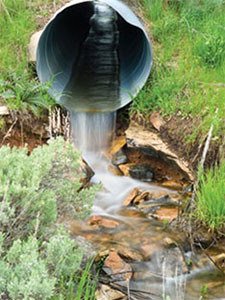Improving culvert design and service life in Minnesota

Researchers at the University’s St. Anthony Falls Laboratory (SAFL) recently completed a project aiming to improve culvert design, installation, and monitoring throughout Minnesota.
As an important component of Minnesota’s drainage network, culverts affect transportation, public and private property, health, quality of life, and safety.
“They’re really an intersection point between the water resources in our state and the transportation infrastructure,” said Jeff Marr, director of engineering and facilities at SAFL, in a CTS research seminar on October 25.
In the seminar, Marr provided an overview of the project and its goals, which included examining pipe material options, evaluating the current practice, and optimizing design for service life and performance. The study—led by Marr and SAFL associate engineer Craig Taylor—was funded by the Minnesota Department of Transportation (MnDOT) and SAFL.
Findings indicate that concrete is currently the most common type of material—about 76 percent of all culverts in Minnesota are concrete. Culverts made of steel pipe are the next most popular, with plastic pipes being by far the least common.
Culvert problems vary significantly by material, the researchers found. For concrete culverts, joint separation is “a major issue,” Marr said. About 18 percent of all concrete culverts in Minnesota have joint separation problems, and about 14 percent of those lead to road damage.
For steel culverts, the researchers found that pH and soil resistivity measurements can help successfully estimate service life. MnDOT’s District 3 currently tracks and records this information in a database, and Marr suggests expanding this practice statewide to help improve design decisions for steel culverts.
There are more than 95,000 culverts in the Minnesota's state highway system.
Marr also said that flaws in culvert installation, such as improper compaction or damage to pipe material coatings, can shorten a culvert’s service life, particularly for certain plastic and steel pipes. “Installation monitoring is key to improved performance,” Marr said.
Therefore, Marr and Taylor suggest adding a third party or contractor to conduct compaction testing when culverts are installed or examining other supplemental pipe inspection methods. Study recommendations also include gasketed joints for all concrete pipes, and more standard design goals for culvert service life. The researchers proposed a 100-year service life standard for centerline and mainline trunk highway culverts and 50 to 75 years for entrance culverts.
According to Andrea Hendrickson, state hydraulic engineer at MnDOT, the project’s recommendations are being considered for inclusion in the MnDOT Drainage Manual.
"These changes should ultimately result in better pipe performance," Hendrickson says.
